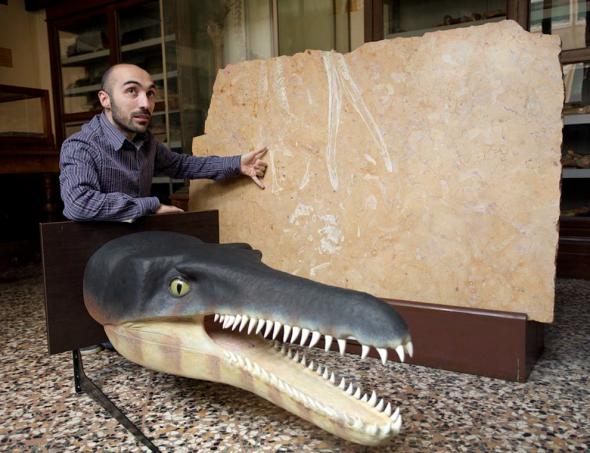By Ker Than, for National Geographic News | December 30, 2010

PHOTOGRAPH COURTESY FEDERICO BORELLA
Fossils found in limestone slabs once destined for Italian homes.
A scientist shows the fossilized limestone next to a head model of the prehistoric crocodile. (Photograph courtesy Federico Borella)
Fossils of a new species of ancient crocodile cousin have been found in limestone once destined for Italian kitchen countertops, a new study says.
The fossils were originally discovered in a limestone quarry in Ferrara, Italy, in 1955 after workers sliced a huge block into four slabs and found the bones trapped inside.
“When the owner noticed the bones, he decided to save” the slabs, said study co-author Federico Fanti, a geologist at the Museo Geologico Giovanni Capellini in Italy.
Scientists performed only a cursory examination of the fossils—enough to determine that they belonged to an ancient crocodile—before the slabs were transferred to two museums in Italy.
The fossils sat unstudied until 2009, when scientists decided to examine them again in more detail.
Analysis of the embedded bones revealed a skull and a few vertebrae that belonged to a previously unknown species of 165-million-year-old prehistoric reptile now named Neptunidraco ammoniticus.
The newfound creature turned out to be the oldest known member of Metriorhynchidae, a family of ancient marine crocodiles that roamed Earth’s oceans for about 30 million years before dying out.
New Crocodile More Like a Dolphin
Scientists think Metriorhynchids split with the ancestors of modern crocodiles about 200 million years ago.
Unlike modern crocodiles, which have semi-aquatic lifestyles, scientists think N. ammoniticus was a fully marine predator that came on land rarely, if ever.
The 13-foot (4-meter) animal was comparable in size to modern crocodiles, but had a more streamlined skull, a more hydrodynamic body, and a vertical tail that more closely resembled those of fish or sharks. (See modern alligator and crocodile pictures.)
Based on previous fossil finds of other Metriorhynchids species, the scientists also suspect N. ammoniticus had flippers.
“It was so adapted to living in the sea that it was unable to survive outside water. In some general aspects, it was more like a dolphin than a croc,” said study co-author Andrea Cau, a paleontologist at Italy’s University of Bologna.
However, for all of their aquatic adaptations, N. ammoniticus and other marine crocodile species did not cut off ties with the surface world completely, Cau noted.
Like whales and dolphins, they had to swim to the ocean surface to breathe, and like sea turtles, they may have clambered up onto beaches once a year to lay their eggs. (See sea turtle pictures.)
Though fearsome by modern standards, N. ammoniticus was also not an alpha predator among its ancient marine counterparts.
For instance, the crocodile cousin was dwarfed by top ocean predators such as the short-necked plesiosaur Liopleurodon, which could grow to more than 80 feet (25 meters).
Marine Crocodiles Successful—To a Point
Fossils of Metriorhynchids have been found all over the world, suggesting they roamed widely across ancient Earth’s oceans.
Based on the size and shape of their teeth, scientists think Metriorhynchids such as N. ammoniticus dined on fish and squid and perhaps other sea reptiles.
But N. ammoniticus is the only crocodile cousin that is known to have lived in the ancient Tethys Ocean, which was located north of the supercontinent Gondwana and is now part of modern-day Italy. (See a prehistoric time line.)
Their presence in Tethys suggests Metriorhynchids were “even more successful” than previously thought, added study co-author Fanti, whose research appears in an upcoming issue of the journal Gondwana Research.
Despite this, the group did not survive, Fanti noted. “They tried to colonize a marine world and survive with what the sea provided, but they failed,” he said.
“Their [terrestrial] cousins have fared much better.”
Crocodile Discovery “Exciting”
Mark Young, a paleontologist at the University of Edinburgh in the United Kingdom, said the discovery of N. ammoniticus offers “an exciting insight into the early evolution” of Metriorhynchids.
For instance, the new species “tells us Metriorhynchids evolved and diversified far earlier than previously thought,” said Young, who was not involved in the study.
The fossils also support the idea that during the age of the dinosaurs, crocodile ancestors “were exceptionally diverse,” Young added in an email.
Besides fully marine crocodiles such as Metriorhynchids, there were also terrestrial crocodiles with mammal-like teeth that later evolved into plant-eating reptiles.
There were also crocodiles that ate both meat and plants, and huge semi-aquatic crocodiles that could take down dinosaurs. (See “Strange Croc Pictures: New Dino-Eater, Galloper, More.”)
Study co-author Fanti added there may be more fossil gems like N. ammoniticus hidden in museums across Europe.
“This is one specimen in our museum, and we have one million specimens,” Fanti said. “So the potential [for new discoveries] is huge.”
Ker Than for National Geographic News – Published December 30, 2010



